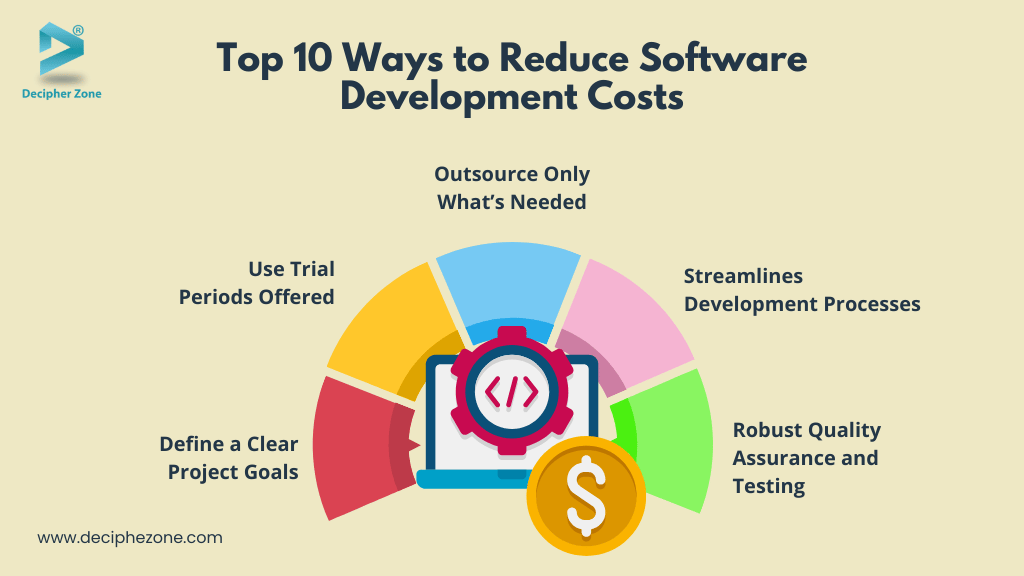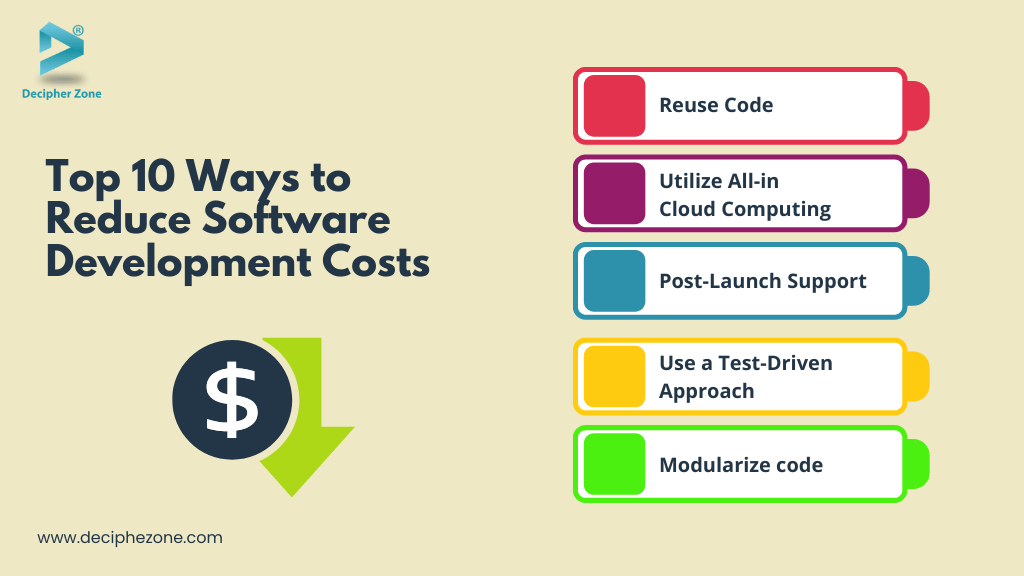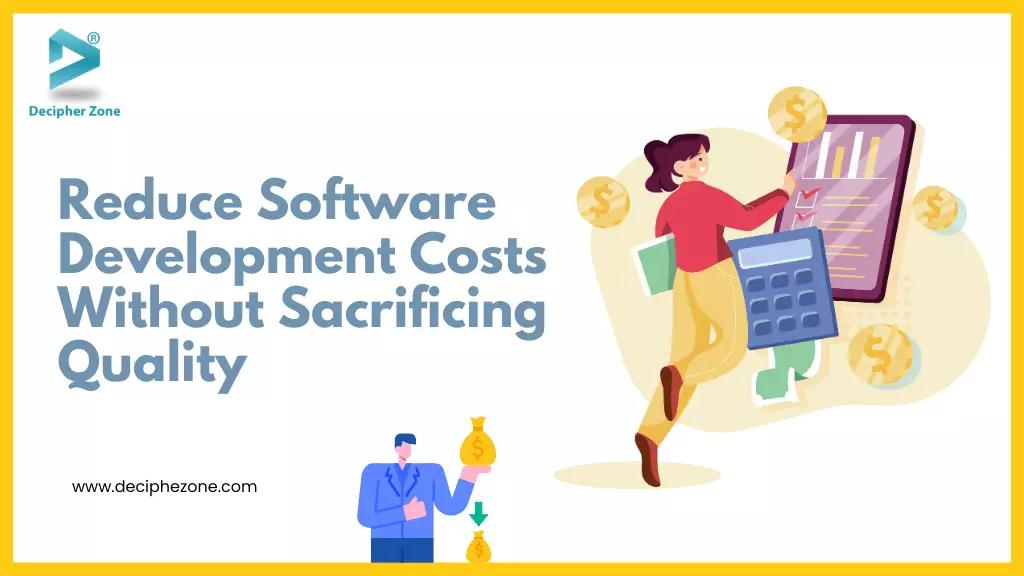Quick Summary: Avoid making mistakes that mostly all are making, Get your hands on the strategies to save costs with this blog. It covers the strategies to reduce software development costs without sacrificing quality. Strategies like defining clear project requirements, outsourcing only what is needed, robust quality assurance and testing, etc can streamline your business profitability as well as user satisfaction.
People mostly wonder why custom software development is expensive and if there are ways to make it more budget-friendly. Custom software development can frequently exceed your initial financial estimates which leaves many clients caught off guard.
The truth is that, while it’s not uncommon for costs to spiral, strategic planning and thoughtful preparation can mitigate these expenses.
You need to be wise while choosing ways to cut development costs as it can be risky practice. Some of the ways can be cost-saving but they may cost you more in the long run in increased maintenance and troubleshooting later.
How to Reduce Software Development Costs Without Sacrificing Quality
The goal of this guide is to save you from the crucial mistake you might make while reducing software development costs, you can find 10 ways to save money without jeopardizing the quality.
These approaches contain everything from optimizing project management processes to making informed decisions about technology choices and providing you with a clearer path to an economically visible solution.
10 Proven Ways to Reduce Software Development Costs for 2025
Keeping the quality and reducing the software development costs is like cooking a sweet dish with crooked rice–a challenging task that requires great skill and precision.
You can face budget overruns, and you need to find strategies to reduce software development costs. Here are the top 10 strategies to reduce software development costs:

1. Define a Clear Project Goals
While examining market and customer expectations, accurately evaluating your specifications and clearly explaining your specific needs can provide you with the greatest software solution. Making it easier for the development team. The more precisely you communicate the more accurate the cost will be.
Considering the budget, the best technology can be used to put your concept into practice. If there is less room for misunderstandings and mistakes, the developers will help you build your application with a dedicated team.
Below are the key steps to follow which can lead to clear communication and minimize the risk of misunderstandings:
-
Do Your Research: Understanding your market, competition, and goals is crucial. This will allow you to make informed decisions regarding features, tech stack, functionality, and potential challenges.
-
Set Realistic Expectations: Set realistic and achievable goals and try not to do too much too soon. Focus on building a robust foundation, then take a step forward with adding features.
-
Create a Detailed Roadmap: Outline your requirements, time estimates, and milestones, helping you stay on track, manage expectations, and avoid unnecessary costly surprises.
2. Use Trial Periods Offered at No-cost or Open-Source Tools
Utilizing trial periods offered by software development providers can be an opportunity for businesses in cost reduction to evaluate software and allows you to make informed decisions and avoid investing in things that may not fully meet your needs.
This approach allows the development teams to thoroughly explore the software features, UI, and performance within the unique requirements.
There are many open-source tools available that are robust, secure, cost-effective, and supported by the expert developer community. These tools and technologies are accustomed to the most cost-saving benefits.
For example, integrating tools including Laravel for backend solutions, ReactJS for dynamic UI, and Kubernetes for container Orchestration can significantly reduce initial costs.
3. Outsource Only What’s Needed
For reducing software development costs, outsourcing is a robust tool, that involves strategically handling specific tasks to experts. This improves the focus on the resources that are most valuable. Think of outsourcing as building a team specifically for your software development tailored to your needs, and this team of specialists contributing to the goal.
With the following key steps, you can strategically outsource to enhance operational efficiency, and cost reduction, and tap into specialized expertise:
-
Don’t Outsource Everything: Only outsource tasks that are out of the syllabus. Evaluate the tasks and determine which specific tasks require external teams. This strategy should consider factors like cost-effectiveness, expertise availability, resource allocation, and overall impact on the operation efficiency. This can create balanced workloads and utilize external capabilities without compromising the core functions.
-
Focus on Core Strength: Think about delegating tasks that highly require knowledge or skills, as these can be handled more effectively by seasoned professionals with the right experience.
-
Gain Control Over Your Budget: Outsourcing allows you to allocate resources to the areas that are vital for software development. This approach is an investment and allows you to maximize the impact and effectiveness of your efforts where they matter most.
4. Streamlines Development Processes
Optimizing processes is essential for an effective cost-reduction strategy. To cut costs and maintain quality, you need to address bottlenecks and eliminate efficiencies. Implementing Agile methodologies like Scrum or Kanban promotes flexibility, collaboration, and continuous improvement.
This approach boosts strong and clear communication to keep everyone on the same page. Making informed decisions and involving in the decision-making process it is necessary to share updates, challenges, and any changes to the project plans with all the team members.
To focus on reducing software development costs through Agile is through incorporating frequent updates and continuous feedback which can prevent costly misalignment. Businesses adopting Agile benefit from reduced rework, faster delivery, and better alignment with customer expectations to make it cost-effective.
5. Robust Quality Assurance and Testing
In this cost-reduction journey, quality assurance and testing play an essential role as strong QA processes can prevent costly defects, reduce the need for rework, and ultimately improve the overall user experience.
Quality assurance and testing is a continuous process and reliability of the final product. By investing in QA and testing, businesses can detect and address potential issues early in the software development process.
Automated testing tools can streamline the testing process as repetitive test cases, regression testing, and code analysis are much faster than manual testing, and free up the development team time and resources.
Taking feedback from the users is equally required to reveal areas for improvement, issues, and challenges that may go unnoticed during the thorough internal testing process.
6. Reuse Code
Code reuse boosts the creation of clean, modular, and efficient applications. By using the existing code, developers can direct their attention towards the design and implementation of innovative features and functionalities rather than spending valuable time reinventing solutions for every new project.
This approach not only streamlines the development process but also reduces the risk of introducing bugs and inconsistencies. Developers utilize tested components that have demonstrated their reliability effectiveness, and productivity, and encourage higher quality and more maintainable software solutions.
By implementing standardized libraries with common code snippets code reusability can save time and costs. Adopting a modular design for reusable components, and allows developers to streamline processes.
Ultimately, it simplifies implementation, and minimizes the need for redundant coding, translating into a cost-effective approach that benefits both developers and stakeholders.
7. Utilize All-in Cloud Computing
Utilizing a complete cloud computing strategy is a powerful move toward reducing software development costs. By using cloud-based services, businesses can save a lot of money. This shift towards cloud computing can not only make operations easier but allow businesses to adjust their resources as needed.
This approach provides infrastructure that allows you to simply put a monthly subscription. This setup also lets easily adjust your storage capacity up or down as needed. This way it eliminates the need for physical servers, reduces maintenance costs, and shifts capital expenditure to manageable operational costs.
Cloud-based services are scalable and allow you to avoid paying for more than you need. By using cloud computing, businesses save on immediate expenses and meet modern demands.
Software updates and maintenance are handled centrally which makes operations simpler and cost-cutting compared to managing them in-house. This improves accessibility and teamwork, while the pay-as-you-go model ensures that you only pay for what you actually use.

8. Post-Launch Support
Post-launch support and maintenance is an essential part of the cost-saving strategy that focuses on maintaining and enhancing the software after deployment. The support ensures the software remains efficient, secure, and aligned with user expectations.
Think of it as a continuous improvement process tailored to your software requirements and needs. This can be achieved with the help of a dedicated team working to optimize its performance and longevity.
With the following key steps, you can use post-launch support and maintenance to minimize costs, sustain long-term value, and improve efficiency:
-
Address Issues Promptly: Monitoring the software to identify and resolve bugs early can prevent small issues from escalating into costly problems. These costly demands extensive repairs. With this approach, you can minimize risks and avoid unnecessary downtime.
-
Optimize Performance Regularly: Focus on fine-tuning the software to ensure it runs smoothly which reduces inefficiencies and improves user satisfaction.
-
Plan for Ongoing Updates: Allocate resources for regular updates that maintain compatibility with advanced technologies. This can prevent going out-of-date and ensures that the software stays relevant.
9. Use a Test-Driven Development Approach
Test-driven development (TDD) is an invaluable approach that improves the quality of software projects while reducing long-term costs. This methodology encourages writing tests before the actual coding process which boosts a proactive environment where potential bugs can be identified and addressed early on.
By implementing this approach, you not only minimize the likelihood of extensive rework later but also make sure that your software aligns closely with the specified requirements. This results in a more robust, reliable, and high-quality final product. This contributes to greater efficiency and satisfaction throughout the development process.
Below are the key steps:
-
Write Tests First: it is essential to write tests that define the behavior you want of the software that way you can have a roadmap handy while while writing the code.
-
Build Code that Passes the Tests: Write the code that successfully meets the requirements outlined by the tests you have designed.
-
Reorganize the Code: Once it passes the tests, you have the opportunity to enhance its structure and design through refactoring and ensure it is more efficient, readable, and maintainable.
10. Modularize code
Modularization is a strong approach to save software development costs by focusing on breaking down your code into smaller, reusable components. This strategy not only enhances and simplifies maintenance but also reduces development time.
Think of it as a Lego block tailored to your software needs, where each piece can be rearranged or reused as required to achieve your goals.
Below are the following key steps to adopt modularization to save costs, improve efficiency, and streamline development:
-
Build Reusable Component: Modularizing can create smaller independent pieces that can be reused across different parts of the application. This reduces the need to write the same code, saving code, time, and effort in future projects.
-
Simplify Updates and Maintenance: When changes are required, you only need to address specific components rather than the entire system, reducing maintenance costs.
-
Improve Team Collaboration: It enables developers to work on different components without interfering with each other’s progress. This improves productivity and accelerates the overall development timeline.
The Bottom Line
Cost efficiency and quality are often seen as conflicting goals, but with the right strategies, they can coexist smoothly. By implementing strategies like defining clear project requirements, outsourcing only what is needed, robust quality assurance and testing, etc, businesses can streamline development, reduce costs, and maintain high standards of quality.
These strategies demonstrate that cost-efficiency doesn’t mean cutting corners. It means optimizing processes, utilizing reusable components, and focusing on smart resource allocation. However, quality is not a luxury but a necessity to thrive in the competitive market.
.avif)
At Decipher Zone, we not just develop software—we offer expert strategies and solutions to help you minimize software development expenses without compromising on quality. Partner with us to create exceptional software solutions.
Our team of experts focuses on efficiency, automation, and smart resource management to ensure your software project is completed on time and within budget.
FAQs
-
How to reduce software development costs without compromising quality?
Yes, it is possible to reduce costs with these strategies, defining clear project requirements, outsourcing only what is needed, robust quality assurance and testing, etc, businesses can streamline development, reduce costs, and maintain high standards of quality.
-
Why is it important to reduce software costs?
Reducing software costs is crucial to boosting profitability, using resources more effectively, and staying competitive in the market. This allows businesses to invest in different areas, innovation, or expansion while maintaining or improving software quality.
-
How much does custom software development cost?
The cost of custom software development ranges from $60,000-$500,000+ depending on the size, features, functionality, technology used, etc. Following is the cost breakdown structure by complexity, which helps clarify spending and maximize value.
-
Simple custom software: $40,000 - $60,000,
-
Advanced custom software: $60,000 - $120,000,
-
Complex custom software: $120,000 - $500,000+.
Author Profile: Mahipal Nehra is the Marketing Manager at Decipher Zone Technologies, specializing in content strategy, and tech-driven marketing for software development and digital transformation.

